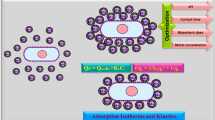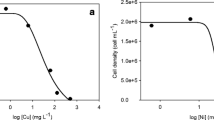Abstract
Microbial biosorption has evolved as an effective strategy for heavy metal removal from contaminated waters. The common cyanobacterium Nostoc muscorum isolated from the banks of a polluted river in Meghalaya, India, was tested for its potential to remove Zn2+ from aqueous solutions. Energy-dispersive X-ray (EDX) study verified Zn binding on the cyanobacterial biomass, and FTIR analysis revealed many negatively charged functional groups (hydroxyl, carbonyl, alcohol, amine, phosphoryl, sulfhydryl, and carboxyl) on the cell surface that aided in metal binding. Thermodynamic studies established the biosorption process to be energetically favorable with negative free energy change (−10.404, −10.599, and −10.796 kJ/mol at 298, 303, and 308 K, respectively). Sorption isotherm data fitted best in the Langmuir isotherm indicating monolayer nature of Zn sorption. The organism showed hyper-accumulation tendency towards Zn with a maximum sorption capacity as high as 2500 mg of Zn taken up per gram of biomass. The separation factor R L calculated from Langmuir isotherm ranged between 0 and 1 signifying favorable interaction between the cyanobacterial biomass and the Zn ions. Various experimental parameters, viz. pH, temperature, inoculum age and size, and shaking rate, influenced Zn biosorption. Optimized experimental conditions significantly enhanced the sorption percentage. Sorption was primarily a fast surface phenomenon in the beginning with internalization of zinc ions by the live cells on prolonged exposure.







Similar content being viewed by others
References
Cain, A., Vannela, R., & Woo, L. K. (2008). Cyanobacteria as a biosorbent for mercuric ion. Bioresource Technology, 99, 6578–6586.
Chakraborty, N., Banerjee, A., & Pal, R. (2011). Biomonitoring of lead, cadmium and chromium in environmental water from Kolkata, North and South-24 Parganas using algae as bioreagent. Journal of Algal Biomass Utilization, 2, 27–41.
Cruz, C. C. V., da Costa, A. C. A., Henriques, C. A., & Luna, A. S. (2004). Kinetic modeling and equilibrium studies during cadmium biosorption by dead Sargassum sp. biomass. Bioresource Technology, 91, 249–257.
Dada, A. O., Olalekan, A. P., Olatunya, A. M., & Dada, O. (2012). Langmuir, Freundlich, Temkin and Dubinin–Radushkevich isotherms studies of equilibrium sorption of Zn2+ unto phosphoric acid modified rice husk. IOSR Journal of Applied Chemistry (IOSR-JAC), 3, 38–45.
De Philippis, R., Colica, G., & Micheletti, E. (2011). Exopolysaccharide-producing cyanobacteria in heavy metal removal from water: molecular basis and practical applicability of the biosorption process. Applied Microbiology and Biotechnology, 92, 697–708.
Desikachary, T. V. (1959). Cyanobacteria. New Delhi: Indian Council of Agriculture Research.
Dixit, S., & Singh, D. P. (2014). An evaluation of phycoremediation potential of cyanobacterium Nostoc muscorum: characterization of heavy metal removal efficiency. Journal of Applied Phycology, 26, 1331–1342.
Dohnalkova, A., Marshall, M. J., Kennedy, D. W., Gorby, Y. A., Shi, L., Beliaev, A. S., Apkarian, R., & Fredrickson, J. K. (2005). The role of bacterial exopolymers in metal sorption and reduction. Microscopy and Microanalysis, 11, 116–117.
Doshi, H., Ray, A., & Kothari, I. L. (2007). Biosorption of cadmium by live and dead Spirulina: IR spectroscopic, kinetics and SEM studies. Current Microbiology, 54, 213–218.
Doshi, H., Seth, C., Ray, A., & Kothari, I. L. (2008). Bioaccumulation of heavy metals by green algae. Current Microbiology, 56, 246–255.
Elrod-Erickson, M., Benson, T. E., & Pabo, C. O. (1998). High-resolution structures of variant Zif268-DNA complexes: implications for understanding zinc finger-DNA recognition. Structure, 6, 45.
European Commission, Final Report. (2002). Heavy metals in waste. Denmark: European Commission on Environment.
Freundlich, H., & Heller, W. (1939). The adsorption of cis- and trans-azobenzene. Journal of American Chemical Society, 61(8), 2282–2230.
Gadd, G. M. (2000). Bioremedial potential of microbial mechanisms of metal mobilization and immobilization. Current Opinion in Biotechnology, 11, 271–279.
Goldberg, S. (2005). Equations and models describing adsorption processes in soils. Soil Science Society of America: Chemical Processes in Soils; SSSA Book Series no. 8.
Goswami, S., Diengdoh, O. L., Syiem, M. B., Pakshirajan, K., & Kiran, M. G. (2015a). Zn(II) and Cu(II) removal by Nostoc muscorum: a cyanobacterium isolated from a coal mining pit in Chiehruphi, Meghalaya, India. Canadian Journal of Microbiology, 61, 209–215.
Goswami, S., Syiem, M. B., & Pakshirajan, K. (2015b). Cadmium removal by Anabaena doliolum Ind1 isolated from a coal mining area in Meghalaya, India: associated structural and physiological alterations. Environmental Engineering Research, 20(1), 41–50.
Gupta, V. K., & Rastogi, A. (2008). Biosorption of lead (II) from aqueous solutions by non-living algal biomass Oedogonium sp. and Nostoc sp.—a comparative study. Colloids and Surfaces B, 64, 170–178.
Gupta, V. K., Rastogi, A., Saini, V. K., & Jain, N. (2006). Biosorption of copper (II) from aqueous solutions by Spirogyra species. Journal of Colloid Interface Science, 296, 59–63.
Hazarika, J., Pakshirajan, K., & Syiem, M. B. (2015). Bioremoval of Cu (II), Zn(II), Pb(II) and Cd(II) by Nostoc muscorum isolated from a coal mining site. Journal of Applied Phycology, 27, 1525–1534.
Hudek, L., Rai, S., Michalczyk, A., Rai, L. C., Neilan, B. A., & Ackland, M. L. (2012). Physiological metal uptake by Nostoc punctiforme. Biometals, 25, 893–903.
Karna, R. R., Uma, L., Subramanian, G., & Mohan, P. M. (1999). Biosorption of toxic metal ions by alkali extracted biomass of a marine cyanobacterium, Phormidium valderianum BDU 30501. World Journal of Microbiology and Biotechnology, 15, 729–732.
Lai, Y. L., Annadurai, G., Huang, F. C., & Lee, J. F. (2008). Biosorption of Zn(II) on the different Ca-alginate beads from aqueous solution. Bioresource Technology, 99, 6480–6487.
Langmuir, I. (1918). The adsorption of gases on plane surfaces of glass, mica and platinum. Journal of American Chemical Society, 40, 1362–1403.
Lim, T. T., Chui, P. C., & Goh, K. H. (2005). Process evaluation for optimization of EDTA use and recovery for heavy metal removal from a contaminated soil. Chemosphere, 58, 1031–1040.
Liu, X., Hu, W., Huang, X., & Deng, H. (2015). Highly effective biosorption of Sr(II) from low level radioactive wastewater. Water Science and Technology, 71(11), 1727–1733.
Lombardi, A. T., Vieira, A. V. H., & Sartori, L. A. (2002). Mucilaginous capsule adsorption and intracellular uptake of copper by Kirchneriella aperta (Chlorococcales). Journal of Phycology, 38, 332–337.
Ma, Z., Jacobsen, F. E., & Giedroc, D. P. (2009). Coordination chemistry of bacterial metal transport and sensing. Chemical Reviews, 109, 4644–4681.
Mackinney, G. (1941). Absorption of light by chlorophyll solutions. Journal of Biological Chemistry, 140, 315–322.
Malik, A. (2004). Metal bioremediation through growing cells. Environment International, 30, 261.
Mane, P. C., & Bhosle, A. B. (2012). Potential of Nostoc muscorum and Anabaena subcylindrica for the bioremoval of some metals from aqueous solution. Journal of Environmental Research And Development, 6(3A), 702–708.
Manikandan, N. A., Alemu, A. K., Goswami, L., Pakshirajan, K., & Pugazhenthi, G. (2016). Waste litchi peels for Cr(VI) removal from synthetic wastewater in batch and continuous systems: sorbent characterization, regeneration and reuse study. Journal of Environmental Engineering © ASCE, ISSN 0733-9372. doi:10.1061/(ASCE)EE.1943-7870.0001099.
Manzini, G., Ceesaro, A., Delbin, F., Paoletti, S., & Reisenhofer, E. (1984). Copper (II) binding by natural ionic polysaccharides. Part I. Potentiometric and spectroscopic data. Bioelectrochemistry and Bioenergetics, 12, 443–454.
Miranda, J., Krishnakumar, G., & D’Silva, A. (2012). Removal of Pb2+ from aqueous system by live Oscillatoria laete-virens (Crouan and Crouan) Gomont isolated from industrial effluents. World Journal of Microbiology and Biotechnology, 28, 3053–3065.
Mohamed, Z. A. (2001). Removal of cadmium and manganese by a non-toxic strain of the fresh water cyanobacterium, Gloeothece magna. Water Research, 35(18), 4405–4409.
Mohan, S., & Karthikeyan, J. (1997). Removal of lignin and tannin color from aqueous solution by adsorption on to activated carbon solution by adsorption on to activated charcoal. Environmental Pollution, 97, 183–187.
Montazer-Rahmati, M. M., Rabbani, P., Abdolali, A., & Keshtkar, A. R. (2011). Kinetics and equilibrium studies on biosorption of cadmium, lead, and nickel ions from aqueous solutions by intact and chemically modified brown algae. Journal of Hazardous Materials, 185, 401–407.
Munoz, R., Alvarez, M. T., Munoz, A., Terrazas, E., Guieysse, B., & Mattisasson, B. (2006). Sequential removal of heavy metals ions and organic pollutants using an algal-bacterial consortium. Chemosphere, 63, 903–991.
Nelson, D. L., & Cox, M. M. (2008). Principles of biochemistry. New York: W. H. Freeman and Company.
Nongrum, N. A., & Syiem, M. B. (2012). Effects of copper ion (Cu2+) on the physiological and biochemical activities of the cyanobacterium Nostoc ANTH. Environmental Engineering Research, 17(S1), S63–S67.
Oguz, E. (2005). Adsorption characteristics and kinetics of the Cr(VI) on the Thuja orientalis. Colloids and Surfaces A: Physicochemical and Engineering Aspects, 252, 121–128.
Packer, L., & Glazer, A. N. (1988). Methods in enzymology: cyanobacteria. San Diego: Academic Press.
Reddy, D. H. K., Lee, S.-M., & Seshaiah, K. (2012a). Biosorption of toxic heavy metal ions from water environment using honeycomb biomass—an industrial waste material. Water Air and Soil Pollution, 223, 5967–5982.
Reddy, D. H. K., Lee, S.-M., & Seshaiah, K. (2012b). Removal of Cd(II) and Cu(II) from aqueous solution by agro biomass: equilibrium, kinetic and thermodynamic studies. Environmental Engineering Research, 17(3), 125–132.
Reddy, K. R., Xie, T., & Dastgheibi, S. (2014). Removal of heavy metals from urban storm-water using different filter materials. Journal of Chemical and Environmental Engineering, 2(1), 282–292.
Ribeiro, R., Magalhães, S., Barbosa, F., Nascentes, C., Campos, I., & Moraes, D. (2010). Evaluation of the potential of microalgae Microcystis novacekii in the removal of Pb2+ from an aqueous medium. Journal of Hazardous Materials, 179, 947–953.
Rippka, R., Deruelles, J., Waterbury, J. B., Herdman, M., & Stanier, R. Y. (1979). Generic assignments, strain histories and properties of pure cultures of cyanobacteria. Journal of General Microbiology, 111, 1–61.
Romera, E., Gonzalez, F., Ballester, A., Blazquez, M. L., & Munoz, J. A. (2006). Biosorption with algae: Statistical review. Critical Reviews in Biotechnology, 26(4), 223–235.
Romero-Gonzalez, M. E., Williams, C. J., & Gardiner, P. H. E. (2001). Study of the mechanism of cadmium biosorption by dealginated seaweed waste. Environmental Science and Technology, 35, 3025–3030.
Sawaya, M. R., Cannon, G. C., Heinhorst, S., Tanaka, S., Williams, E. B., Yeates, T. O., & Kerfeld, C. A. (2006). The structure of beta-carbonic anhydrase from the carboxysomal shell reveals a distinct subclass with one active site for the price of two. Journal of Biological Chemistry, 281, 7546–7555.
Sharma, M., Kaushik, A., Kiran, B. S., & Kamra, A. (2008). Sequestration of chromium by exopolysaccharides of Nostoc and Gloeocapsa from dilute aqueous solutions. Journal of Hazardous Materials, 157, 315–318.
Singh, D. P. (1985). Cu2+ transport in the unicellular cyanobacterium Anacystis nidulans. Journal of General and Applied Microbiology, 31, 277–284.
Subramanian, G., & Uma, L. (1996). Cyanobacteria in pollution control. Journal of Scientific and Industrial Research, 55, 685–692.
Terry, P. A., & Stone, W. (2002). Biosorption of cadmium and copper contaminated water by Scenedesmus abundans. Chemosphere, 47, 249–255.
Umrania, V. V. (2006). Bioremediation of toxic heavy metals using acidothermophilic autotrophies. Bioresource Technology, 97, 1237–1242.
Valls, M., & de Lorenzo, V. (2002). Exploiting the genetic and biochemical capacities of bacteria for the remediation of heavy metal pollution. FEMS Microbiology Reviews, 26, 327–338.
Xu, P., Zeng, G. M., Huang, D. L., Feng, C. L., Hu, S., Zhao, M. H., Lai, C., Wei, Z., Huang, C., Xie, G. X., & Liu, Z. F. (2012a). Use of iron oxide nanomaterials in wastewater treatment: a review. Science of the Total Environment, 424, 1–10.
Xu, P., Zeng, G. M., Huang, D. L., Lai, C., Feng, C. L., Zhao, M. H., Wei, Z., Li, N. J., Huang, C., & Xie, G. X. (2012b). Adsorption of Pb(II) by iron oxide nanoparticles immobilized Phanerochaete chrysosporium: equilibrium, kinetic, thermodynamic and mechanisms analysis. Chemical Engineering Journal, 203, 423–431.
Acknowledgements
The authors would like to thank University Grants Commission (UGC-F. No. 41-1254/2012 (SR); dated July 26, 2012) and Department of Biotechnology (DBT-F. No. BT/216/NE/TBP/2011; dated May 02, 2012) for financial assistance. Assistance in the form of instruments from FTIR unit of Chemistry Department and atomic absorption spectroscopy and SEM-EDX facility in Sophisticated Analytical Instrumentation Facility (SAIF), NEHU, is also acknowledged.
Author information
Authors and Affiliations
Corresponding author
Ethics declarations
Conflict of interest
The authors declare that they have no conflict of interest.
Rights and permissions
About this article
Cite this article
Diengdoh, O.L., Syiem, M.B., Pakshirajan, K. et al. Zn2+ sequestration by Nostoc muscorum: study of thermodynamics, equilibrium isotherms, and biosorption parameters for the metal. Environ Monit Assess 189, 314 (2017). https://doi.org/10.1007/s10661-017-6013-4
Received:
Accepted:
Published:
DOI: https://doi.org/10.1007/s10661-017-6013-4




